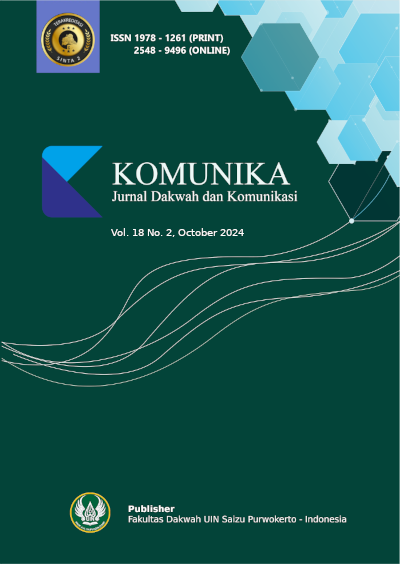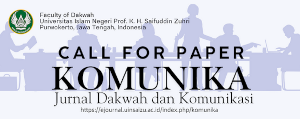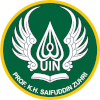Unveiling the Mysteries: Human Communication with Jinn - Myth or Reality?
DOI:
https://doi.org/10.24090/komunika.v18i2.10777Keywords:
Human Communication, transcendental communication, Myth, Jinn, supernatural beingAbstract
Al-Qur'an regulates all forms of communication: with Allah, fellow humans, and spirits/jinn. In human Communication with Jinn, Allah reported through the story of the fall of the Prophet Adam and Siti Hawa from heaven after consuming the khuldi fruit. Both slipped because of a jinn's instigation in Allah's name. It proves that apart from Jinn and humans being able to communicate, the potential for deception is also genuine. Therefore, this research aims to explain the communication/relationship between humans and Jinn. This qualitative research method uses a thematic approach to verses from Al-Qur'an relating to human and Jinn communication. Data was from literature by analyzing books and scientific journals with similar themes. Data analysis uses the transcendental communication/magical communication paradigm. The research results show that Al-Qur'an explained that human Communication with Jinn exists. However, it does not need to be developed. Human and Jinn communication has many negative effects. The negative impact is that humans will always be filled with anxiety, will tend to commit crimes, and will be classified as the actions of people who are misguided and disobedient to Allah. Some Jinns are believers, and some are unbelievers. However, humans cannot differentiate them because they are supernatural beings. Communication between humans and Jinn generally occurs through ruqyah syar'iyyah rituals to improve the community's economy and shamanic practices.Downloads
References
A.G., H., Ruslijanto, H., & Mulyono, D. (2000). Metode Penulisan dan Penyajian Karya Ilmiah. Buku kedokteran EGC.
Abror Mhd. (2020). Moderasi Beragama dalam Bingkai Toleransi ( Kajian Islam dan Keberagaman ). Rusydiah, 1(1), 137–148.
Adlini, M. N., Dinda, A. H., Yulinda, S., Chotimah, O., & Merliyana, S. J. (2022). Metode penelitian kualitatif studi pustaka. Edumaspul: Jurnal Pendidikan, 6(1), 974–980.
Akhmad, P. (2013). Memahami Ruqyah Syar’iyah dan Ruqyah Gadungan (Syirkiyyah). Adamssein Media.
Aminullah, M. (2022). Filsafat Komunikasi Islam dalam Pendekatan Alamtologi (Mencari Bentuk Satu Disiplin Ilmu). Liwaul Dakwah: Jurnal Kajian Dakwah Dan Masyarakat Islam, 12(1), 1–17.
Arni, A. (2021). Impelentasi Ruqyah Syar’iyah Sebagai Alternatif Psikoterapi dalam Kajian Psikologi Islam. Jurnal Studi Insania, 9, No 1, 1–22. https://doi.org/10.18592/jsi.v9i1.3923
Bakar, R. A. (2014). Tarian Kuda Kepang : Animisme dalam Kesenian Masyarakat Jawa : Kuda Kepang Dance : Animism In The Art Of Java Community. Jurnal Peradaban Melayu, 9, 30–41.
Creswell, J. (2015). Educational research, planning, conducting, and evaluating quantitative and qualitative. Pearson Education.Inc.
Deddy, M. (2000). Ilmu Komunikasi : Suatu Pengantar (Cetakan Pe). Renada Rosdakarya.
Dzulhusna, N., Nurhasanah, N., & Suherman, Y. N. (2022). Qaulan Sadida, Qaulan Ma’rufa, Qaulan Baligha, Qaulan Maysura, Qaulan Layyina dan Qaulan Karima Itu Sebagai Landasan Etika Komunikasi Dalam Dakwah. Journal Of Islamic Social Science And Communication (JISSC) DIKSI, 1(02), 76–84.
Hajar, I. I. (2014). Sejarah Agama dalam al-Qur’an; Dari Sederhana Menuju Sempurna. TSAQAFAH, 10(2), 393–412. https://doi.org/10.21111/TSAQAFAH.V10I2.194
Harahap, N. (2020). Penelitian Kualitatif (H. Sazali (ed.); 1st ed.). Wal ashri Publishing. Jl. Ekarasmi Medan Sumatera Utara.
Hardin. (2016). Komunikasi Transendental Pada Ritual Kapontasu Dalam sistem Parladangan Masyarakat Etnik Muna. Jurnal Penelitian Komunikasi Dan Opini Publik, 20, No 1.
Hasanah, H. (2016). Arah Pengembangan Dakwah Melalui Sistem Komunikasi Islam. AT-TABSYIR: Jurnal Komunikasi Penyiaran Islam, 4(1), 131–156. http://journal.iainkudus.ac.id/index.php/komunikasi/article/download/2910/2081
Hasanah, U. (2013). Mengungkap Rahasia Setan Dalam Al-Qur’an. Jurnal IAIN Kudus, 7, No 1.
Hazmi, H. (2017). Perancangan Buku Ilustrasi Kehidupan Jin Untuk Remaja. Seni Rupa, 05(03).
Hefni, H. (2015). Komunikasi Islam. Kencana.
Hendra, T. (2020). Komunikasi Islam Pada Masyarakat Multikultural. Jurnal Al-Bayan: Media Kajian Dan Pengembangan Ilmu Dakwah, 26(1), 127–149.
Hermawan, H. (2017). Jin, Setan, dan Iblis dalam Tafsir Departemen Agama RI. UIN Sunan Kalijaga Yogyakarta.
Hidayani, N. (2022). Prinsip-Prinsip Mendengar Menurut Ungkapan Al-Qur’an Dan Pengembangannya Dalam Konseling Islam. UIN Ar-Raniry Fakultas Dakwah dan Komunikasi.
Indrianto, N. (2020). Pendidikan Agama Islam Interdisiplier untuk Perguruan Tinggi (Edisi Pert). Deepublish Publisher.
Junaedi, E. (2019). Inilah Moderasi Beragama Perspektif Kemenag. Multikultural Dan Multireligius, 18(2), 182–186. https://doi.org/10.32488/harmoni.v18i2.414
Kallang, A. (2018). Konteks Ibadah Menurut Al-Quran. Al-Din: Jurnal Dakwah Dan Sosial Keagamaan, 4(2), 1–13. https://doi.org/10.35673/ajdsk.v4i2.630
Laila, A. (2019). Ruqyah Sebagai Pengobatan Berbasis Spiritual Untuk Mengatasi Kesurupan. Junal Bimbingan Konseling Dan Dakwah Islam, 16, No 2, 216–226. https://doi.org/https://doi.org/10.14421/hisbah.2019.161-09
Makmun, S. (2017). Interaksi antara jin dan manusia menurut syekh Muhammad Ali Al-Shabuni: Studi analisis terhadap Kitab Shafwah Al-Tafasir. UIN Sunan Gunung Djati Bandung.
Murniarti, E. (2019). Sejarah Komunikasi, Pengaruh Perkembangan Teknologi Komunikasi, Sejarah Perkembangan Ilmu Komunikasi dan Teori-teori komunikasi. Mr. Admin Repository.
Nurdin, A. (2015). Komunikasi Magis. LkiS.
Padge, G. R. H. (2008). Komunikasi Kontemporer : Strategi, Konsepsi, dan Sejarah. Jurnal Komunikasi.
Qarima, N., Ismaiya, K. D., & Raihanah, S. (2023). IMPELEMENTASI MAGIS TERHADAP PENINGKATAN EKONOMI DI KALANGAN MASYARAKAT. Religion: Jurnal Agama, Sosial, Dan Budaya, 1(6), 1245–1250.
R.I., D. A. (2010). Al-Qur’an dan Tafsirnya jilid 7 : 19-20-21. Lentera Abadi.
Rogers, E. M. (1986). Communication Technology The New Media In Society. Free Press.
Rumakat, M. T., Saleh, F., & Yati, A. M. (2021). Komunikasi Jin dalam Mempengaruhi Manusia Menurut Al-Qur’an : Studi Analisis di Rumah Sehat Aceh, Indonesia. Ar Raniry International Journal Of Islamic Studies, 8, No1, 92–103. https://doi.org/http://dx.doi.org/10.22373/jar.v8i1.10998
Shihab, M. Q. (2021). Yang Tersembunyi Jin, Iblis, Setan dan Malaikat Dalam Al-Qur’an Dan As-Sunnah Serta Wacana Pemikiran Ulama Masa Lalu dan Masa Kini (Edisi Baru). Lentera Hati.
Soib, A. (2019). RELASI ANTARA JIN DAN MANUSIA DALAM AL-QUR’AN. UIN SUNAN KALIJAGA YOGYAKARTA.
Sugiyono. (2012). Metode Penelitian Pendekatan Kualitatif, Kuantitatif, dan R@D. Alfabeta.
Sumaryanto, E., & Ibrahim, M. (2023). Komunikasi Antar Budaya Dalam Bingkai Teori-Teori Adaptasi. Journal Nusantara Hasana, 3, No. 2. https://doi.org/https://doi.org/10.59003/nhj.v3i2.895
Suryani, W. (2015). Komunikasi Transendental Manusia-Tuhan. Farabi, 12(1), 150–163.
Suryani, W. (2022). Etika Komunikasi Dalam Islam. Saf: Jurnal Komunikasi Dan Penyiaran Islam, 1(2), 22–37.
Yaqin, M. I., & Faris. (2022). Komunikasi Transendental Penganut Kapitayan Dalam Peningkatan Kesadaran Spiritual. Commed: Jurnal Komunikasi Dan Media, 7(1), 15–29.
Yuhanda, G. P. (2020). Komunikasi Transendental Praktisi Supranatural Dengan Khodam Untuk Penyembuhan Penyakit Non Medis. Jurnal Komversal, 2, No 1, 3. https://doi.org/10.38204/komversal.v6i1.388
Zuliansyah, M. A., Antoni, & Suryadi. (2017). Sowan Kyai, Komunikasi Perspektif Islam Jawa. Jurnal Komunikator, 9(2), 94–104.
Downloads
Published
Issue
Section
License
Copyright (c) 2024 Muktarruddin, Khatibah

This work is licensed under a Creative Commons Attribution-ShareAlike 4.0 International License.
Authors who publish with this journal agree to the following terms:
- Authors retain copyright and grant the journal right of first publication with the work simultaneously licensed under a Creative Commons Attribution-ShareAlike 4.0 International License that allows others to share the work with an acknowledgement of the work's authorship and initial publication in this journal.
- Authors are able to enter into separate, additional contractual arrangements for the non-exclusive distribution of the journal's published version of the work (e.g., post it to an institutional repository or publish it in a book), with an acknowledgement of its initial publication in this journal.
- Authors are permitted and encouraged to post their work online (e.g., in institutional repositories or on their website) prior to and during the submission process, as it can lead to productive exchanges, as well as earlier and greater citation of published work (See The Effect of Open Access).

























